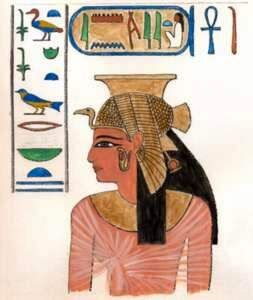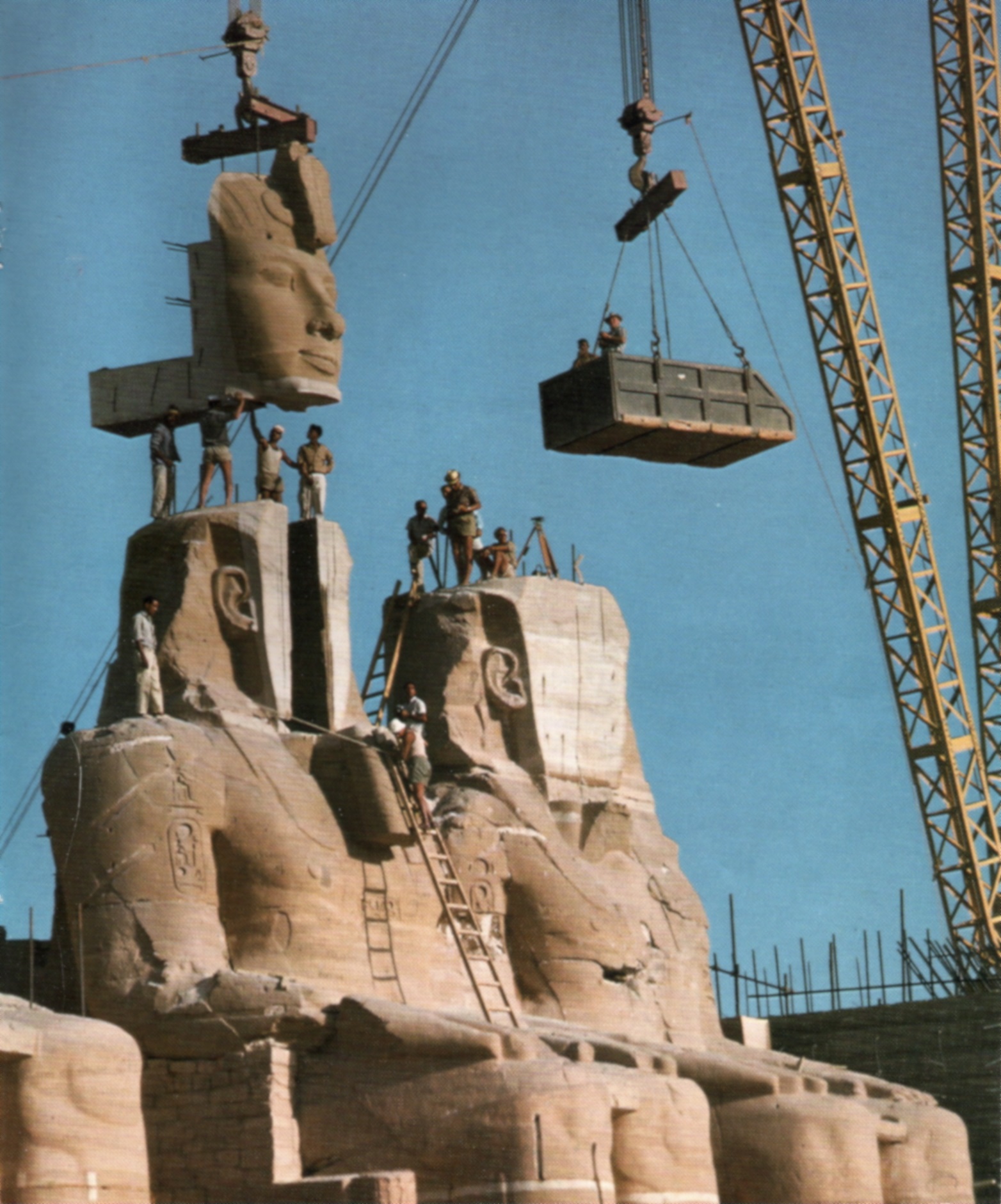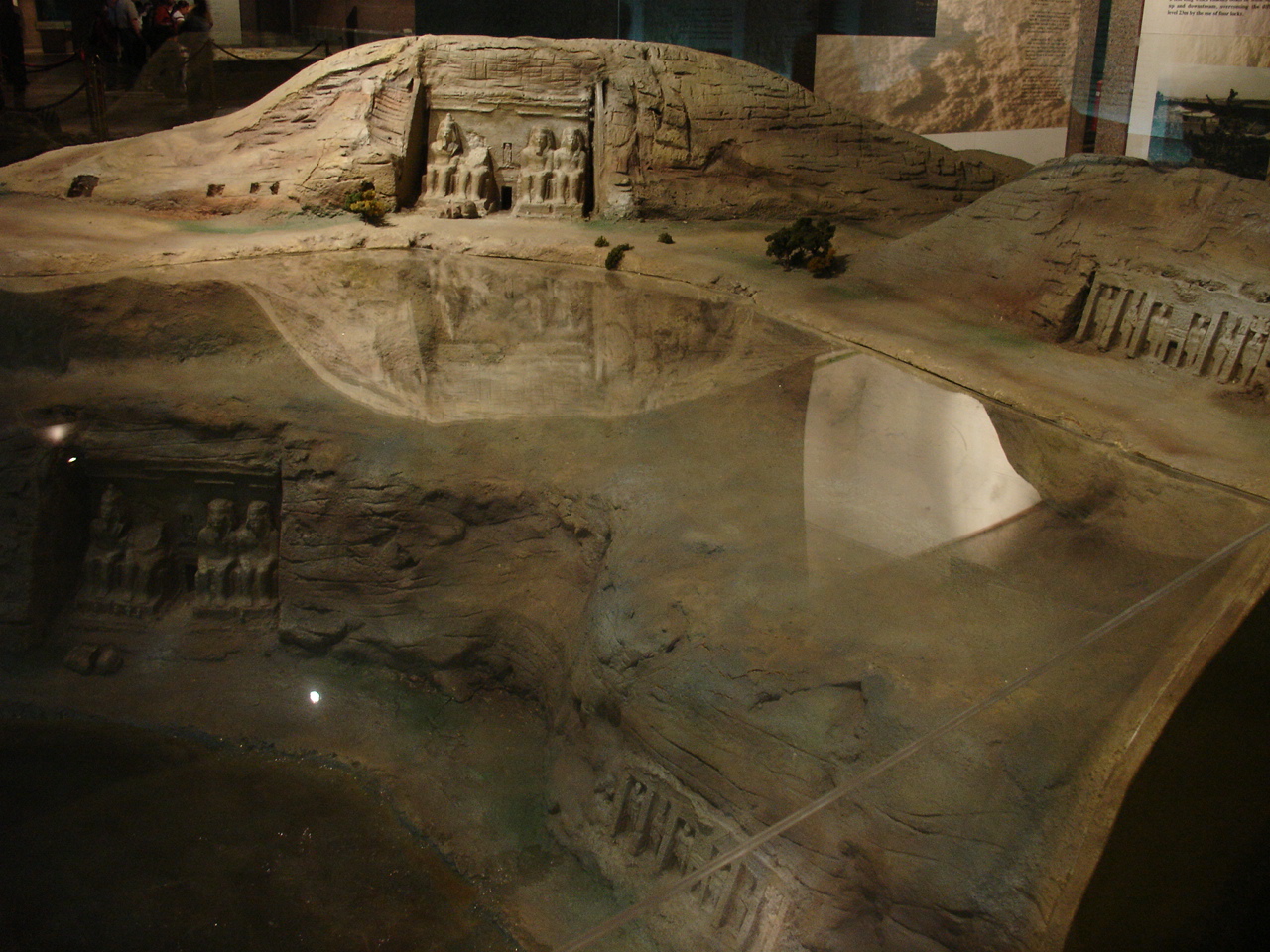|
Meryatum
Meryatum (“Beloved of Atum”) was an ancient Egyptian prince and High Priest of Re, the son of Pharaoh Ramesses II and Queen Nefertari. He is shown as 16th on the processions of princes, and is likely to have been the last child born to Ramesses and Nefertari (after Amun-her-khepeshef, Pareherwenemef, Meritamen, Henuttawy and Meryre). He is depicted in the Smaller Abu Simbel temple, dedicated to Nefertari. Inscriptions at Karnak and elsewhere show Nefertari was his mother. He visited Sinai in the second decade of his father's reign, and later in that decade was appointed as High Priest of Ra in Heliopolis, a position he held for the next twenty years. Two of his statues are now in Berlin and a stela belonging to him is in Hildesheim. An ostrakon mentions work on his tomb and that of Isetnofret; it implies he was buried in the area of the Valley of the Queens, though it is also possible he was buried in KV5, the tomb built for the sons of Ramesses, since a fragment ... [...More Info...] [...Related Items...] OR: [Wikipedia] [Google] [Baidu] |
Meritamen
Meritamen (also spelled ''Meritamon'', ''Meritamun, Merytamen, Merytamun, Meryt-Amen''; ancient Egyptian: ''Beloved of Amun'') was a daughter and later Great Royal Wife of Pharaoh Ramesses the Great, born by his first queen Nefertari. Family Meritamen was a daughter of Ramesses and his first Great Royal Wife, Nefertari. She appears as the fourth daughter in the list of daughters in Abu Simbel and had at least four brothers: Amun-her-khepeshef, Pareherwenemef, Meryre and Meryatum, as well as a sister named Henuttawy. Meritamen may have had more brothers and sisters, but these five are known from the facade of Queen Nefertari's temple in Abu Simbel. Her eldest brother, Amun-her-khepeshef, was the crown prince until at least year 25 of the reign of their father. Prince Prehirwenemef is known to have served in the army and is depicted in the battle scenes from Kadesh. The youngest sibling known to us, Prince Meryatum, would later become High Priest of Re in Heliopolis. ... [...More Info...] [...Related Items...] OR: [Wikipedia] [Google] [Baidu] |
Nefertari
Nefertari, also known as Nefertari Meritmut, was an Egyptian queen and the first of the Great Royal Wife, Great Royal Wives (or principal wives) of Ramesses II, Ramesses the Great. She is one of the best known Egyptian queens, among such women as Cleopatra VII, Cleopatra, Nefertiti, and Hatshepsut, and one of the most prominent not known or thought to have queen regnant, reigned in her own right. She was highly educated and able to both read and write hieroglyphs, a very rare skill at the time. She used these skills in her diplomatic work, corresponding with other prominent royals of the time. Her lavishly decorated tomb, QV66, is one of the largest and most spectacular in the Valley of the Queens. Ramesses also constructed a temple for her at Abu Simbel next to his colossal monument there. Translation of name There are different interpretations of the meaning of the name Nefertari. Nefertari means 'beautiful companion' and Meritmut means 'Beloved of the goddess Mut'. Some sour ... [...More Info...] [...Related Items...] OR: [Wikipedia] [Google] [Baidu] |
High Priest Of Re
The High Priest of Ra or of Re was known in Egyptian as the ''wr-mꜢw'', which translates as Greatest of Seers. The main cult of Ra was in ancient Heliopolis, northeast of present-day Cairo. The high priests of Ra are not as well documented as the high priests of other deities such as Amun and Ptah. List of high priests ;Old Kingdom (c. 2686 BCE – 2181 BCE) * Imhotep, time of Djoser, Third Dynasty * Prince Rahotep, possibly son of Sneferu, Fourth Dynasty ; Middle Kingdom (c. 2055 BCE–1550 BCE) * Nubkaura-ankh, from offering table and rock inscription * Khakaureemhat, papyrus from Lahun * Maakherure-emhutaat, seal * Ra, seal * Khentyhetep Iyemiatib, seal * Iuefsenef, seal ;New Kingdom (c. 1550 BCE–1069 BCE) ;;Eighteenth Dynasty * Ahmose, son of Amenhotep II. Served during the reign of Thutmose IV * Pawah served during the reign of Akhenaten ;;Nineteenth Dynasty * Bak (High Priest of Re) Bak was a royal charioteer and later high priest of Re. * Amenemope, son of ... [...More Info...] [...Related Items...] OR: [Wikipedia] [Google] [Baidu] |
Ramesses II
Ramesses II (sometimes written Ramses or Rameses) (; , , ; ), commonly known as Ramesses the Great, was an Pharaoh, Egyptian pharaoh. He was the third ruler of the Nineteenth Dynasty of Egypt, Nineteenth Dynasty. Along with Thutmose III of the Eighteenth Dynasty of Egypt, Eighteenth Dynasty, he is often regarded as the greatest, most celebrated, and most powerful pharaoh of the New Kingdom of Egypt, New Kingdom, which itself was the most powerful period of ancient Egypt. He is also widely considered one of ancient Egypt's most successful warrior pharaohs, conducting no fewer than 15 military campaigns, all resulting in victories, excluding the Battle of Kadesh, generally considered a stalemate. In Ancient Greek literature, ancient Greek sources, he is called Ozymandias, derived from the first part of his Egyptian-language regnal name: . Ramesses was also referred to as the "Great Ancestor" by successor pharaohs and the Egyptian people. For the early part of his reign, he focu ... [...More Info...] [...Related Items...] OR: [Wikipedia] [Google] [Baidu] |
Abu Simbel
Abu Simbel is a historic site comprising two massive Rock-cut architecture, rock-cut Egyptian temple, temples in the village of Abu Simbel (village), Abu Simbel (), Aswan Governorate, Upper Egypt, near the border with Sudan. It is located on the western bank of Lake Nasser, about southwest of Aswan (about by road). The twin temples were originally carved out of the mountainside in the 13th century BC, during the Nineteenth Dynasty of Egypt, 19th Dynasty reign of the Pharaoh Ramesses II. Their huge external rock relief figures of Ramesses II have become iconic. His wife, Nefertari, and children can be seen in smaller figures by his feet. Sculptures inside the Great Temple commemorate Ramesses II's heroic leadership at the Battle of Kadesh. The complex was Structure relocation, relocated in its entirety in 1968 to higher ground to avoid it being submerged by Lake Nasser, the Aswan Dam reservoir. As part of International Campaign to Save the Monuments of Nubia, an artificia ... [...More Info...] [...Related Items...] OR: [Wikipedia] [Google] [Baidu] |
Abu Simbel Temples
Abu Simbel is a historic site comprising two massive rock-cut temples in the village of Abu Simbel (), Aswan Governorate, Upper Egypt, near the border with Sudan. It is located on the western bank of Lake Nasser, about southwest of Aswan (about by road). The twin temples were originally carved out of the mountainside in the 13th century BC, during the 19th Dynasty reign of the Pharaoh Ramesses II. Their huge external rock relief figures of Ramesses II have become iconic. His wife, Nefertari, and children can be seen in smaller figures by his feet. Sculptures inside the Great Temple commemorate Ramesses II's heroic leadership at the Battle of Kadesh. The complex was relocated in its entirety in 1968 to higher ground to avoid it being submerged by Lake Nasser, the Aswan Dam reservoir. As part of International Campaign to Save the Monuments of Nubia, an artificial hill was made from a domed structure to house the Abu Simbel Temples, under the supervision of a Polish ... [...More Info...] [...Related Items...] OR: [Wikipedia] [Google] [Baidu] |
Henuttawy (19th Dynasty)
Henuttawy ("Mistress of the Two Lands") was an ancient Egyptian princess of the 19th Dynasty. Biography Henuttawy was a daughter of Pharaoh Ramesses II and the Great Royal Wife Nefertari and half-sister of Merneptah. She is seventh on the lists of Ramesses's daughters and the second of two daughters whose mother is certain to have been Nefertari. Her statue stands in the small Abu Simbel temple, built for Nefertari. The children of Nefertari are usually identified on the basis of this temple: the princes Amunherkhepeshef, Pareherwenemef, Meryre and Meryatum and the princesses Meritamen and Henuttawy. Henuttawy is not depicted on the facade of the large Abu Simbel temple, where the first two sons and the six eldest daughters of Ramesses are shown, along with Nefertari and Queen Mother Tuya. Tomb QV73 Her tomb in the Valley of the Queens, QV73 is not far from those of other members of Ramesses's family (QV68 – Meritamen, QV71 – Bintanath, QV75 – Henutmire); it is between ... [...More Info...] [...Related Items...] OR: [Wikipedia] [Google] [Baidu] |
Pareherwenemef
Pareherwenemef (Pre-hir-wonmef, Prehirwenemef, Rehirwenemef ) was an ancient Egyptian prince of the Nineteenth Dynasty of Egypt, the third son of Pharaoh Ramesses II, the second by Queen Nefertari. Family Pareherwenemef was a son of Pharaoh Ramesses II and Queen Nefertari. Prince Amunherkhepeshef is an older brother. Younger brothers include Meryre and Meryatum. The Princesses Henuttawy, Meritamen and Nebettawy were his sisters. Life Pareherwenemef was present at the Battle of Kadesh and is depicted in the Abu Simbel temple.Dodson, Aidan and Hilton, Dyan. The Complete Royal Families of Ancient Egypt. Thames & Hudson. 2004.pp 160-161, 163, 167, 173. In the Kadesh inscriptions an incident is mentioned where two Hittite spies are captured. The interrogation reveals that the enemy is much closer than previously thought. The royal family quickly fled to the west, away from danger, led by Prince Pareherwenemef. The prince was called "First Brave of the Army" and later became "S ... [...More Info...] [...Related Items...] OR: [Wikipedia] [Google] [Baidu] |
Roemer-und-Pelizaeus-Museum
The Roemer- und Pelizaeus-Museum Hildesheim is an archaeological museum in Hildesheim, Germany. Mostly dedicated to ancient Egyptian and ancient Peruvian art, the museum also includes the second largest collection of Chinese porcelain in Europe. Furthermore, the museum owns collections of natural history, ethnology, applied arts, drawings and prints, local history and arts, as well as archeology. Apart from the permanent exhibitions, the museum hosts temporary exhibitions of other archaeological and contemporary topics. In 2000, the old building, originally built in the 1950s, was replaced by a new building, significantly increasing the space available for exhibitions. The current museum is the result of the union of the Roemer Museum, founded in 1844 (and named after one of the founders, Hermann Roemer), and the Pelizaeus Museum, established in 1911, that had housed the private collection of Egyptian antiques of Wilhelm Pelizaeus. Repatriation In 2023 the museum was one o ... [...More Info...] [...Related Items...] OR: [Wikipedia] [Google] [Baidu] |
Isetnofret
Isetnofret (or Isis-nofret or Isitnofret) (Ancient Egyptian: "the beautiful Isis") was one of the Great Royal Wives of Pharaoh Ramesses II and was the mother of his successor, Merneptah. She was one of the most prominent of the royal wives, along with Nefertari, and was the chief queen after Nefertari's death (around the 24th year of the pharaoh's reign). Family The parents of Isetnofret are not known. She must have married Ramesses II even before he came to the throne as her eldest children already appear in scenes from the time of Seti I. She had at least three sons and one daughter. Her children include: * Prince Ramesses, Crown Prince from Year 25 to 50 of Ramesses II * Princess-Queen Bintanath, firstborn daughter and later wife of RamessesDodson & Hilton, p.170 * Prince Khaemwaset, High Priest of Ptah. Crown Prince from Year 50 to 55 of Ramesses II * Pharaoh Merneptah, Ramesses' 13th son and ultimate successor (he outlived the first 12 princes) * Pr ... [...More Info...] [...Related Items...] OR: [Wikipedia] [Google] [Baidu] |
Plinth (hieroglyph)
The total number of distinct Egyptian hieroglyphs increased over time from several hundred in the Middle Kingdom to several thousand during the Ptolemaic Kingdom. In 1928/1929 Alan Gardiner published an overview of hieroglyphs, Gardiner's sign list, the basic modern standard. It describes 763 signs in 26 categories (A–Z, roughly). Georg Möller compiled more extensive lists, organized by historical epoch (published posthumously in 1927 and 1936). In Unicode, the block ''Egyptian Hieroglyphs'' (2009) includes 1071 signs, organization based on Gardiner's list. As of 2016, there is a proposal by Michael Everson to extend the Unicode standard to comprise Möller's list. Subsets Notable subsets of hieroglyphs: * Determinatives * Uniliteral signs * Biliteral signs * Triliteral signs * Egyptian numerals Letter classification by Gardiner List of hieroglyphs See also *Egyptian hieroglyphs *Transliteration of Ancient Egyptian * Gardiner's sign list *List of cuneiform sig ... [...More Info...] [...Related Items...] OR: [Wikipedia] [Google] [Baidu] |
Bennu Bird
Bennu () is an ancient Egyptian deity linked with the Sun, creation, and rebirth. He may have been the original inspiration for the phoenix legends that developed in Greek mythology. Roles According to Egyptian mythology, Bennu was a self-created being said to have played a role in the creation of the world. He was said to be the '' ba'' (personality component of the soul) of the sun deity Ra, and to have enabled the creative actions of Atum. The deity was said to have flown over the waters of Nun that existed before creation, landing on a rock and issuing a call that determined the nature of creation. He was also a symbol of rebirth and, therefore, was associated with Osiris. Some of the titles of Bennu were "He Who Came Into Being by Himself", and "Lord of Jubilees"; the latter epithet referring to the belief that Bennu periodically renewed himself like the sun was thought to do. His name is related to the Egyptian verb ''wbn'', meaning "to rise in brilliance" or "to shine" ... [...More Info...] [...Related Items...] OR: [Wikipedia] [Google] [Baidu] |





